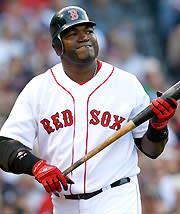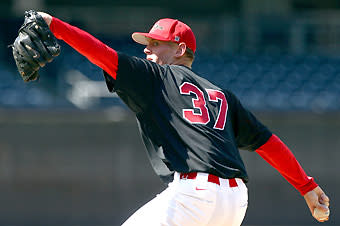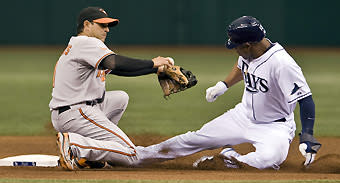Can Big Papi end his power outage?
BOSTON – The sudden inability of David Ortiz(notes) to drive a baseball out of the ballpark seems baffling, but scouts and statisticians alike have had clues.
The Boston Red Sox began a West Coast trip in Anaheim on Tuesday night and Ortiz was still looking for his first home run of the season, spanning 142 plate appearances and 116 at-bats.
The Big Papi power outage has its roots in 2007, the year after he hit a home run every 10.3 at-bats to finish with a career-high 54. His ratio of home runs to at-bats worsened to one in 15.7 in 2007 and to one in 18.1 last year. Even if he recovers to hit home runs for the rest of this season at the same rate he did in 2007, he would wind up with just 28, five more than he hit last season when injuries limited him to 109 games.

The Red Sox' David Ortiz is averaging .224 and has no home runs this season.
(Jim Rogash/Getty Images)
Scouts have noticed changes in Ortiz's swing and have difficulty predicting whether he'll recapture the power that enabled him to hit 231 homers since coming to the Red Sox in 2003.
"He's not driving the ball the other way, he's not catching up to fastballs, he's a complete enigma,'' said one major-league scout who watched Ortiz in a half-dozen games recently.
Said another scout: "It's a small sample, but everything looks slow – his bat, his body. He is slow on fastballs, isn't reacting well to off-speed stuff, and when he goes the other way, he's hitting flyballs and not driving the ball. And you know it's in his head now, too.''
Ortiz is adamant that he will emerge from his horrific slump, and has expressed agitation at what he perceives a lack of support from those who used to lead the cheers for him in Boston. However, unlike in New York, where fans have already taken to booing Mark (.198 batting average) Teixeira, fans in Fenway Park have not yet turned on Ortiz.
And Red Sox manager Terry Francona has not dropped Ortiz from the No. 3 spot in the batting order, expressing confidence that his designated hitter will come around.
But will he? Ortiz is 33, had wrist surgery last season and his knees have been troublesome in the past and remain a constant source of concern.
His performance at this stage resembles another large-bodied first baseman, Cecil Fielder, who at age 33 in 1997 hit three home runs in his first 201 at-bats and finished the season with 13 home runs in 98 games for the Yankees. A year later, after hitting 17, Fielder's big-league career was over.
Since 1954, there have been 19 players who have hit 50 home runs in a season, including Ortiz, who hit a career-high 54 in 2006. Of those 19, only one, Greg Vaughn, went longer at the start of a season than Ortiz without a home run. Vaughn, who hit 50 for the San Diego Padres in 1998, went the first 37 games in 2002 for the Tampa Bay Rays without a home run. On May 18, on his 159th plate appearance and 133rd at-bat, he finally connected, and later hit another homer in the same game.
Vaughn, 36 that season, wound up batting .163 with eight home runs, and retired a year later.
Of the other 50-homer hitters, no one else has begun a season as dismally as Ortiz. Not one-season wonders such as Brady Anderson or Luis Gonzalez. Not Hall of Famers such as Willie Mays, even when he was 42 and at the end of his career with the Mets, or Mickey Mantle, in his last year on shredded knees with the Yankees. Not Roger Maris, even after his slugging feats in New York were a distant memory in St. Louis, nor Sammy Sosa(notes), hanging on at the end in Texas.
Ortiz is not the only struggling big bopper in the American League. Ortiz's slugging percentage entering play Tuesday was .328, the same as erstwhile Seattle strongman Adrian Beltre(notes), who had one home run in 128 at-bats. Detroit's Magglio Ordonez(notes), who in 2007 hit a league-leading 54 doubles to go along with 28 home runs, was at .306, and Tampa Bay's young star B.J. Upton(notes), whose season was delayed while he recuperated from shoulder surgery, is homerless in 102 at-bats, his slugging percentage at .216.
Six weeks is far too early to write off anyone, especially someone who has performed the way Ortiz has the past six seasons for the Red Sox. But is there reason for concern? Absolutely.


San Diego State pitcher Stephen Strasburg is expected to be drafted No. 1 in the June amateur draft..
(Donald Miralle/Getty Images)
Heat of the moment: Stephen Strasburg gave them something to remember him by when he threw a no-hitter against Air Force while striking out 17 in his final home game at San Diego State. The 6-foot-5 right-hander, who has 164 K's in 87 1/3 innings and has registered numerous 100 mph readings on radar guns, is widely expected to be the No. 1 player taken in the June amateur draft. There is talk that adviser Scott Boras will be looking to shatter all records for deals given a No. 1 pick, perhaps seeking a package as much as $50 million. One veteran scout who has worked in Southern California for over 30 years said Strasburg is the best college pitcher he has ever seen.
But here's something for the Washington Nationals, who own the No. 1 pick, to ponder as they prepare to go to battle with Boras.
Since the draft began in 1965, a dozen pitchers have been taken No. 1 overall. Their combined won-loss record: 822-853. Only four – Mike Moore, Andy Benes, Tim Belcher, and Floyd Bannister – have won as many as 100 games in the major leagues (the jury is out on top picks Luke Hochevar(notes) and David Price(notes), who have just started their careers).
Moore has the most wins of any No. 1, 161, but he lost more games (176) than he won. Only four of the No. 1's finished with a winning record: Matt Anderson (15-7, injured), Ben McDonald (78-70), Benes (155-139) and Belcher (146-140).
Only Benes, Moore, and Bannister were All-Stars, only Belcher and Moore started World Series games (Price pitched in relief last season) and only McDonald (3.91) and Benes (3.97) had a career earned run average under 4.00.
Sure thing? No such thing.

The Rays' Carl Crawford, right, steals second base as Baltimore's Brian Roberts loses the ball.
(AP Photo/Steve Nesius)
Honor among thieves: The stolen base appears to be making a comeback in the American League, where the average number of steals per game (.74) is the highest it has been since 2001. That was the apex of the steroids era, so improved drug testing and a subsequent drop in power numbers don't really wash as an explanation. AL hitters are actually hitting balls out of the yard at a faster rate (one per 34.6 at-bats) than last season (one per 36.1), and the weather hasn't even warmed up yet.
A better reason for the up-tick in thievery can be found on the leader board. Tampa Bay's Carl Crawford(notes), who has stolen 22 bases and has yet to be caught this season, is on pace to steal 108. That would be the most in the AL since Hall of Fame inductee Rickey Henderson stole 108 in 1983, the year after he set the big-league record with 130 steals. Vince Coleman of the Cardinals, who stole 100 or more bases in three consecutive seasons (1985-87) is the only big leaguer since to go over the century mark.
Meanwhile, Boston's Jacoby Ellsbury(notes), who has 15 steals, is on pace to steal 76 after leading the league with 50 as a rookie last season. Bobby Abreu(notes) and Chone Figgins(notes) of the Angels each have 12, putting them on pace for 65.
There's no telling how many bases Crawford would steal if he could play against Boston on a daily basis. Crawford tied a big-league record with six steals in a game against the Red Sox, stole two more a week later in Boston, and 10 of his 22 steals have come against the Sox. He didn't steal a bag in the team's first series, which opened the season in Boston – maybe it was too cold to run.
On second thought: Chad Finn, a former colleague at the Boston Globe, reminded me of an interview I had with shortstop Orlando Cabrera(notes) in 2005 when I broached the topic of Manny Ramirez(notes) and steroids. Cabrera laughed at the question. "My brother (Jolbert) played with Manny in Cleveland," he said. "And Manny hated needles. Every spring, when they took their physicals, Manny would take off, and four, five guys would chase him down. He just hated needles. There's no way he would have ever juiced himself. He just worked hard. When we go on the road, Manny would be out of his room at 8 o'clock, going to the gym. And he practiced hard. He went out to Fenway Park many times to learn how to play the Wall, and he never – never – skipped going to the cage."
Wonder what Cabrera thinks today.

Isringhausen
Circling the bases: Look for the Rays to call up former Cardinals closer Jason Isringhausen(notes) any time now. Meanwhile, the Rays, who insisted that they optioned David Price to the minors not for financial reasons but because they felt he needed more seasoning, looks like they made the right call. Price, dazzling out of the bullpen in the postseason, is 1-4 with a 4.74 ERA in six starts in Triple-A Durham, and the left-hander has given up 24 hits and walked 16 in 24 2/3 innings. … Those close to the scene in Houston say that just because the Astros picked up Cecil Cooper's contract extension through the 2010 season does not protect him from an early dismissal if the Astros are out of contention at the All-Star break. The same source said commissioner Bud Selig made a call on Cooper's behalf to Houston owner Drayton McLane, who was on the fence about picking up Cooper's option. Closer Jose Valverde(notes) would seem certain to be dealt at the break if the Astros are out of it, and while Carlos Lee(notes) and Roy Oswalt(notes) have no-trade clauses, it wouldn't be a surprise if GM Ed Wade, who wants to grow his club younger, explores moving them as well. … What do two of the surprise teams so far, Toronto and St. Louis, have in common? The impact made by their managers, Cito Gaston and Tony La Russa. Gaston's touch with young hitters is being proven yet again with the Blue Jays, while baseball people marvel at how La Russa is able to maximize the ability of players lightly regarded by others – or do you think there was a long line of people clamoring for Ryan Ludwick(notes) when he was in Cleveland? … Speaking of the Indians, one scout said he had the impression that the underachieving Tribe was playing "tense" under manager Eric Wedge. … The biggest surprise out of Arizona is not that they fired manager Bob Melvin and brought in player development head A.J. Hinch to manage, but that the Diamondbacks gave Hinch, who had never coached or managed on the professional level, a four-year deal.
